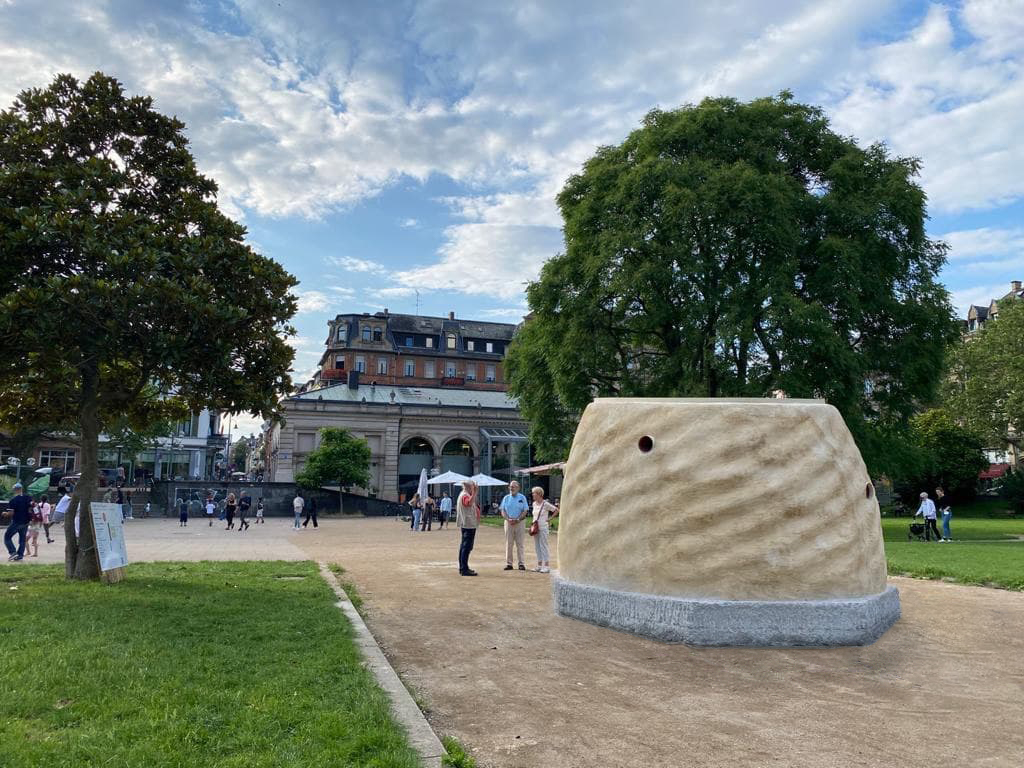 Art and culture come to life with CRANE WASP technology, the sustainable and livable 3D printing.
Art and culture come to life with CRANE WASP technology, the sustainable and livable 3D printing.
WASP, italian company leader in 3D printing, has completed the printing phase of the sculpture "The House of Dust", the first and only temporary, livable and sustainable artwork entirely 3D printed based on natural materials with Crane WASP technology. In collaboration with the Museum Wiesbaden, the livable sculpture by artist Alison Knowles, pioneer of the Fluxus movement, synonymous with the gradual transition between art and life, was created for the first time in the world using 3D printing.
In 1967, Alison Knowles, with the artwork "The House of Dust" activated a reflection on the man-machine relationship using a Siemens 4004 computer that wrote a poem in Fortran language. The first example of computer-generated poem, which created strophes by working through iterations of verses with words changing from a finite word list. Knowles’s collaboration with the computer highlighted the underlying arbitrariness of language, demonstrating how words acquire different meanings through structural relationships and shifting contexts.
In 1968, the computer-generated poem was translated into a physical structure in Chelsea, New York and later found new life in Cal Arts Burbank, California.
Today, in 2021, the artist chooses the Crane WASP 3D printer to reactivate his poem and build a new physical structure layer upon layer in natural material. The artist chooses WASP because it represents the synthesis of technological advancement in the dialogue between man and technology and between man and new ways of living. Inspired by the potter wasp, since 2012, WASP (World’s Advanced Saving Project) has been developing construction processes based on the principles of the circular economy and digital fabrication. On the market since 2021, build 3D printed houses in the sustainable way with the first Crane WASP multi-printer system through continuous research on printable natural materials.
On the occasion of the 75th anniversary of the state of Hesse, the exhibition "tinyBE • living in a sculpture" comes to life on the Kranzplatz, Kochbrunnenplatz in Wiesbaden. “The House of Dust" artwork printed by WASP can be synthesized in: 50 hours of printing, 500 machine codes (G-code), 165 layers of 15 mm, 15 km of extrusion, 8 cubic meters of natural materials. The total surface of the sculpture is 16 square meters for a total height of 2.5 m.
The transformation of ways of living and working in a world influenced by globalization, digitization and climate change is one of the central themes of our time. “Developing processes to give a home as a birthright for every man is a responsibility of the most advanced societies. The humblest materials, the waste from the agro-food chain and the raw earth deposited by a machine at the point and in the quantity proportionate to transform the shapeless matter at house is the process that WASP is developing. Living in a sculpture is the crystallization of the process. ”Says Massimo Moretti, Founder of WASP.
Alison Knowles' artwork is one of ten temporary livable sculptures by international artists in the Frankfurt / Rhine-Main metropolitan region, which can be seen in Frankfurt, Darmstadt and Wiesbaden until September 26.
Do the sculptures make us think about what is indispensable and what is sustainable?
Sleeping one night inside the "The House of Dust" sculpture opens the mind to new forms of living.
Overnight stays can also be booked.
The realization of the project was possible thanks to the collaboration of:
Alison Knowles: Artist
tinyBE: Curators of the exhibition and art platform
Zaeske Architekten: Architecture Studio
Karrie Bau Gruppe: Construction site support
Ricehouse: Material supplier
www.3dwasp.com